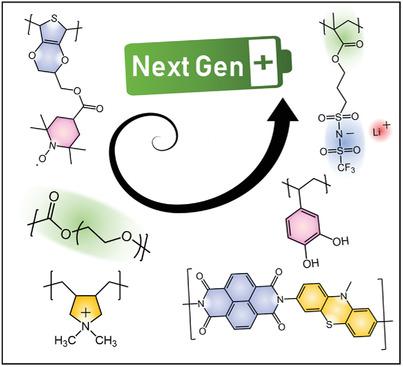当前位置:
X-MOL 学术
›
Macromol. Chem. Phys.
›
论文详情
Our official English website, www.x-mol.net, welcomes your
feedback! (Note: you will need to create a separate account there.)
Innovative Polymers for Next‐Generation Batteries
Macromolecular Chemistry and Physics ( IF 2.5 ) Pub Date : 2020-01-23 , DOI: 10.1002/macp.201900490 David Mecerreyes 1, 2 , Luca Porcarelli 1 , Nerea Casado 1
Macromolecular Chemistry and Physics ( IF 2.5 ) Pub Date : 2020-01-23 , DOI: 10.1002/macp.201900490 David Mecerreyes 1, 2 , Luca Porcarelli 1 , Nerea Casado 1
Affiliation

|
Lithium‐ion batteries are part of modern life, being present in daily‐used objects such as mobile phones, tablets, computers, watches, sport accessories, electric scooters, and cars. The next‐generation batteries require the development of innovative polymers that help to improve their performance in terms of power density, cyclability, raw materials' availability, low weight, printability, flexibility, sustainability, or security. This article highlights recent developments in the area of redox‐active, electronic/ionic conducting polymers. This includes the development of innovative binders for electrodes, polymer electrolytes, and redox polymers. All these new polymer developments are leading to new battery technologies such as metal–polymer batteries, organic batteries, polymer–air, and redox–flow batteries, which are expected to complement the current lithium‐ion technologies in the future.
中文翻译:

下一代电池的创新聚合物
锂离子电池是现代生活的一部分,存在于日常使用的物体中,例如手机,平板电脑,计算机,手表,运动配件,电动踏板车和汽车。下一代电池需要开发创新的聚合物,以帮助提高功率密度,可循环性,原材料的可用性,重量轻,可印刷性,灵活性,可持续性或安全性等方面的性能。本文重点介绍了氧化还原活性电子/离子导电聚合物领域的最新发展。这包括开发用于电极,聚合物电解质和氧化还原聚合物的创新粘合剂。所有这些新的聚合物开发都引领着新的电池技术,例如金属聚合物电池,有机电池,聚合物空气和氧化还原液流电池,
更新日期:2020-01-23
中文翻译:

下一代电池的创新聚合物
锂离子电池是现代生活的一部分,存在于日常使用的物体中,例如手机,平板电脑,计算机,手表,运动配件,电动踏板车和汽车。下一代电池需要开发创新的聚合物,以帮助提高功率密度,可循环性,原材料的可用性,重量轻,可印刷性,灵活性,可持续性或安全性等方面的性能。本文重点介绍了氧化还原活性电子/离子导电聚合物领域的最新发展。这包括开发用于电极,聚合物电解质和氧化还原聚合物的创新粘合剂。所有这些新的聚合物开发都引领着新的电池技术,例如金属聚合物电池,有机电池,聚合物空气和氧化还原液流电池,











































 京公网安备 11010802027423号
京公网安备 11010802027423号